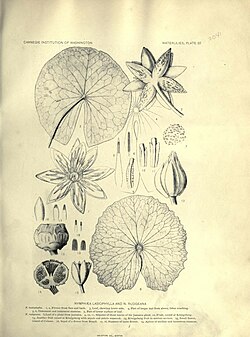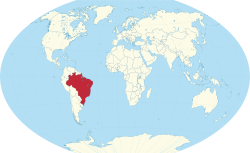Biology:Nymphaea lasiophylla
| Nymphaea lasiophylla | |
|---|---|

| |
| Botanical illustration of Nymphaea lasiophylla and Nymphaea rudgeana from the publication "The Waterlilies, a Monograph of the Genus Nymphea" by Henry Shoemaker Conard (1905) | |
| Scientific classification | |
| Kingdom: | Plantae |
| Clade: | Tracheophytes |
| Clade: | Angiosperms |
| Order: | Nymphaeales |
| Family: | Nymphaeaceae |
| Genus: | Nymphaea |
| Species: | N. lasiophylla
|
| Binomial name | |
| Nymphaea lasiophylla Mart. & Zucc.[1]
| |

| |
| Nymphaea lasiophylla is native to East Brazil[1] | |
| Synonyms[1] | |
| |
Nymphaea lasiophylla is a species of waterlily native to East Brazil. It has also been introduced to the Venezuelan Antilles.[1]
Description
Vegetative characteristics
Nymphaea lasiophylla is an aquatic herb[2] with cylindrical tubers.[3] The leaf blade is suborbicular to orbicular and has an entire, flat margin. The actinodromous leaf venation with impressed veins[2] has 7-11 primary veins.[4]
Generative characteristics
The nocturnal flowers float on the water surface.[2] The crimson red, 6-7 mm long carpellary appendages are clavate.[4]
The strongly aromatic,[5] solvent-like floral fragrance consists of twelve compounds: Methyl hexanoate, Methyl 2-methylbutanoate, Ethyl 2-methylbutanoate, Methyl 2-hydroxy-2-methylbutanoate, Methyl 3-hydroxy-2-methylpropanoate, Benzyl alcohol, Benzaldehyde, Methyl benzoate, Benzyl 2-methylbutanoate, Anisole, (methoxymethyl)benzene, and 1.4-dimethoxybenzene.[6]
Cytology
The diploid chromosome count is 2n = 18.[5]
Reproduction
Vegetative reproduction
Both stolons[5] and proliferating pseudanthia are present. Nymphaea lasiophylla forms 1-2 secondary proliferating pseudanthia.[7] They are the main mode of reproduction in this species.[5][8] The tubers, which often develop leaves and roots prior to their detachment, break off easily from the proliferating pseudanthia. They briefly float in the water and grow into new plants elsewhere.[5]
Generative reproduction
While generative reproduction does occur, its significance is diminished by the prominence of vegetative reproduction through proliferating pseudanthia.[8] Seeds were only observed in one of 20 populations.[5]
Taxonomy
It was first described by Carl Friedrich Philipp von Martius and Joseph Gerhard Zuccarini in 1832.[1]
Type specimen
The type specimen was collected close to Joazerio in the state of Bahia, Brazil.[3][9][4]
Placement within Nymphaea
It is placed in Nymphaea subgenus Hydrocallis.[5]
Segregation of Nymphaea caatingae
Plant material previously believed to be Nymphaea lasiophylla was later assigned to a new species, Nymphaea caatingae.[3]
Etymology
The specific epithet lasiophylla means woolly-leaved.[10] However, the name is misleading, as the authors mistook a layer of algae as trichomes.[4][9][5]
Conservation
Nymphaea lasiophylla may face loss of habitat, due to climate change.[11]
Ecology
Habitat
Nymphaea lasiophylla is found growing in temporary bodies of water along roadsides, in depressions in arid climate regions, in coastal lagoons,[12] in artificial ponds, and in stagnant waters.[5] Populations of Nymphaea lasiophylla have the ability to persist in and dominate temporary aquatic habitats.[13] It occurs sympatrically with Nymphaea vanildae.[7]
Pollination
It is pollinated by the beetle species Cyclocephala putrida.[6] Beetles have been discovered trapped within flowers, which close during the day.[5]
References
- ↑ 1.0 1.1 1.2 1.3 1.4 "Nymphaea lasiophylla Mart. & Zucc." (in en). Royal Botanic Gardens, Kew. http://www.plantsoftheworldonline.org/taxon/281436-2. Retrieved 18 December 2023.
- ↑ 2.0 2.1 2.2 Pellegrini, M. O. O. & Jardim Botânico do Rio de Janeiro. (n.d.-b). Nymphaea lasiophylla Mart. & Zucc. Flora E Funga Do Brasil. Retrieved December 18, 2023, from https://floradobrasil.jbrj.gov.br/FB10944
- ↑ 3.0 3.1 3.2 de Lima, C. T., Machado, I. C., & Giulietti, A. M. (2021). "Nymphaeaceae of Brasil." Sitientibus série Ciências Biológicas, 21.
- ↑ 4.0 4.1 4.2 4.3 Henkel, F., Rehnelt, F., Dittmann, L. (1907). "Das Buch der Nymphaeaceen oder Seerosengewächse." p. 77. Deutschland: Henkel.
- ↑ 5.00 5.01 5.02 5.03 5.04 5.05 5.06 5.07 5.08 5.09 Wiersema, J. H. (1987). A monograph of Nymphaea subgenus Hydrocallis (Nymphaeaceae). Systematic Botany Monographs, 1-112.
- ↑ 6.0 6.1 Maia, A. C. D., de Lima, C. T., Navarro, D. M. D. A. F., Chartier, M., Giulietti, A. M., & Machado, I. C. (2014). "The floral scents of Nymphaea subg. Hydrocallis (Nymphaeaceae), the New World night-blooming water lilies, and their relation with putative pollinators." Phytochemistry, 103, 67-75.
- ↑ 7.0 7.1 De Lima, C. T., & Guilietti, A. M. (2013). "Nymphaea vanildae (Nymphaeaceae): A new species from the Caatinga in Brazil." Phytotaxa, 134(1), 42-48.
- ↑ 8.0 8.1 Grob, V., Moline, P., Pfeifer, E., Novelo, A. R., & Rutishauser, R. (2006). "Developmental morphology of branching flowers in Nymphaea prolifera." Journal of Plant Research, 119, 561-570.
- ↑ 9.0 9.1 Conard, H. S. (2015). The Waterlilies: A Monograph of the Genus Nymphaea (Classic Reprint). pp. 207-208. USA: FB&C Limited.
- ↑ Stearn, W. T. (1983). Botanical latin: History, Grammar, Syntax, Terminology, and Vocabulary. p. 455.
- ↑ Nzei, J. M., Ngarega, B. K., Mwanzia, V. M., Kurauka, J. K., Wang, Q. F., Chen, J. M., ... & Pan, C. (2022). "Assessment of climate change and land use effects on Water Lily (Nymphaea L.) habitat suitability in South America." Diversity, 14(10), 830.
- ↑ de Sousa, D. J. L., & Matias, L. Q. (2012). "Synopsis of genus Nymphaea L.(Nymphaeaceae) in state of Ceará." Revista Caatinga, 25(3), 72-78.
- ↑ Tabosa, A. B., Matias, L. Q., & Martins, F. R. (2012). "Live fast and die young: the aquatic macrophyte dynamics in a temporary pool in the Brazilian semiarid region." Aquatic Botany, 102, 71-78.
Wikidata ☰ Q15483286 entry
 |

